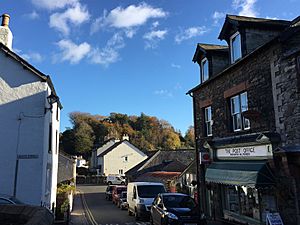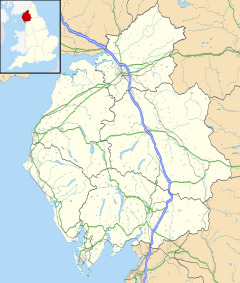Broughton-in-Furness facts for kids
Quick facts for kids Broughton in Furness |
|
|---|---|
| Town | |
 Prince's Street, Broughton-in-Furness |
|
| Population | 529 (2011) |
| OS grid reference | SD2087 |
| Civil parish |
|
| Unitary authority |
|
| Ceremonial county | |
| Region | |
| Country | England |
| Sovereign state | United Kingdom |
| Post town | BROUGHTON-IN-FURNESS |
| Postcode district | LA20 |
| Dialling code | 01229 |
| Police | Cumbria |
| Fire | Cumbria |
| Ambulance | North West |
| EU Parliament | North West England |
| UK Parliament |
|
Broughton in Furness is a small, charming market town in Cumbria, England. It's located right on the edge of the amazing Lake District National Park. In 2011, about 529 people lived here. This area, called Furness, used to be part of Lancashire a long time ago.
Contents
History of Broughton in Furness
Broughton in Furness is a very old town. It was even mentioned in the Domesday Book in 1086. This was a huge survey of England ordered by William the Conqueror.
The town started to grow around the 11th century. It became an important market place for local farmers and fishers. Wool was a very important product that helped the town develop. Broughton was officially given a special charter in 1575. This allowed it to hold regular markets.
The main Market Square was designed in 1760. This was done by John Gilpin Sawrey, who owned the land. He lived nearby at Broughton Tower, a large mansion. The Old Town Hall was one of the key buildings built around the square.
In the 1990s, a main road (the A595) was moved away from the town center. This helped Broughton keep its quiet, rural feel.
How Broughton is Governed
Broughton is part of the Cumbria County Council and the South Lakeland District Council areas. These are local government groups. In 1976, several smaller local councils joined together. They formed the Duddon Parish Council. This council helps manage local services for the community.
Geography and Nature
Broughton is located close to the River Duddon. It's also not far from the coast, near a small village called Foxfield.
A special area nearby is called Duddon Mosses. It's a protected site because of its wildlife. You can find deer, lizards, and even adders (a type of snake) there. Barn owls also live in this natural area.
With only 529 people, Broughton-in-Furness is a smaller town in the UK.
Economy and Tourism
For a long time, Broughton's economy was based on fishing and farming. There is still a regular market where livestock (farm animals) are sold.
In the 1950s, the Lake District National Park was created. This brought more tourists to the area. Today, there is a Tourist Information Centre in the main square. It helps visitors find out about things to do.
Culture and Community Life
The Victory Hall is a community building in Broughton. It was recently updated with special funding. The hall hosts plays and musical events for everyone to enjoy.
The town has several shops. You can find a Post Office, a newsagent, a grocer, and a bakery. There are also a few pubs and restaurants.
In the center of the town square is a tall stone pillar called an obelisk. It was built in 1810. This marked the 50th year that King George III was king. Syke House is an old, attractive building on the edge of town. It has dates from 1655 and 1740 carved into it.
Broughton has a busy tennis club with two outdoor courts. You can also go sailing on nearby Coniston Water. Eccle Riggs is a large old house south of town. It is now a leisure club where people can relax and have fun.
Media and News
If you live in Broughton, you can watch local news on TV. These include BBC North West Tonight and ITV Granada Reports.
For local radio, you can listen to BBC Radio Cumbria or Heart North West. There's also Smooth Lake District and Cando FM, which is a local community radio station. The town's local newspapers are the North West Evening Mail and The Westmorland Gazette.
Transport and Travel
The Furness Railway built a train line to Broughton station in 1848. Another line from Whitehaven also reached Broughton in 1850. Later, in 1859, the line was extended through Broughton to Coniston.
The train line to Coniston closed for passengers in 1958. It fully closed in 1962. Part of the old railway path is now a public path for walking or cycling. Broughton's closest train station today is Foxfield railway station. It is about 2 miles (3.2 km) southwest of the town.
The main road, the A595, used to go right through Broughton. Now, the A595 goes around the town. The road that runs through Broughton is now called the C5009. You might still see old signs with A595 on them.
Education in Broughton
Broughton has a Church of England primary school for younger children. The old school building, which is now a private home, can still be seen on Church Street.
There are no secondary schools directly in Broughton. Older students usually travel to schools in nearby towns. These include John Ruskin School in Coniston or Ulverston Victoria High School. Some students also go to Windermere School. After age 16, many young people travel to Barrow-in-Furness. They attend Furness College or Barrow Sixth Form College for further education.
Church and Religion
The local church is called St Mary Magdalene's. It is an Anglican church. The church has been around since Saxon times, but the oldest part of the building today is from the 12th century.
It is still an active church and is part of the diocese of Carlisle. The church building is considered a Grade II listed building. This means it is a historically important building.
Notable People from Broughton
- Richard Parsons is an author known for his best-selling study guides for GCSE exams.
- Sir Robin Philipson (1916–1992) was a famous artist who was born in the town.
- Branwell Brontë, the brother of the famous Brontë sisters (who wrote books like Jane Eyre), lived in Broughton for six months in 1840.
See also
 In Spanish: Broughton in Furness para niños
In Spanish: Broughton in Furness para niños





